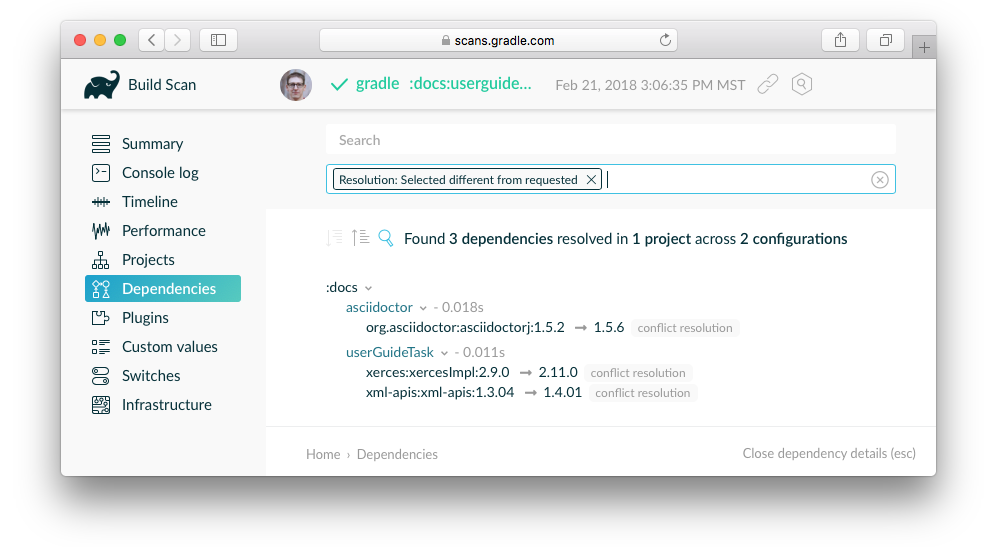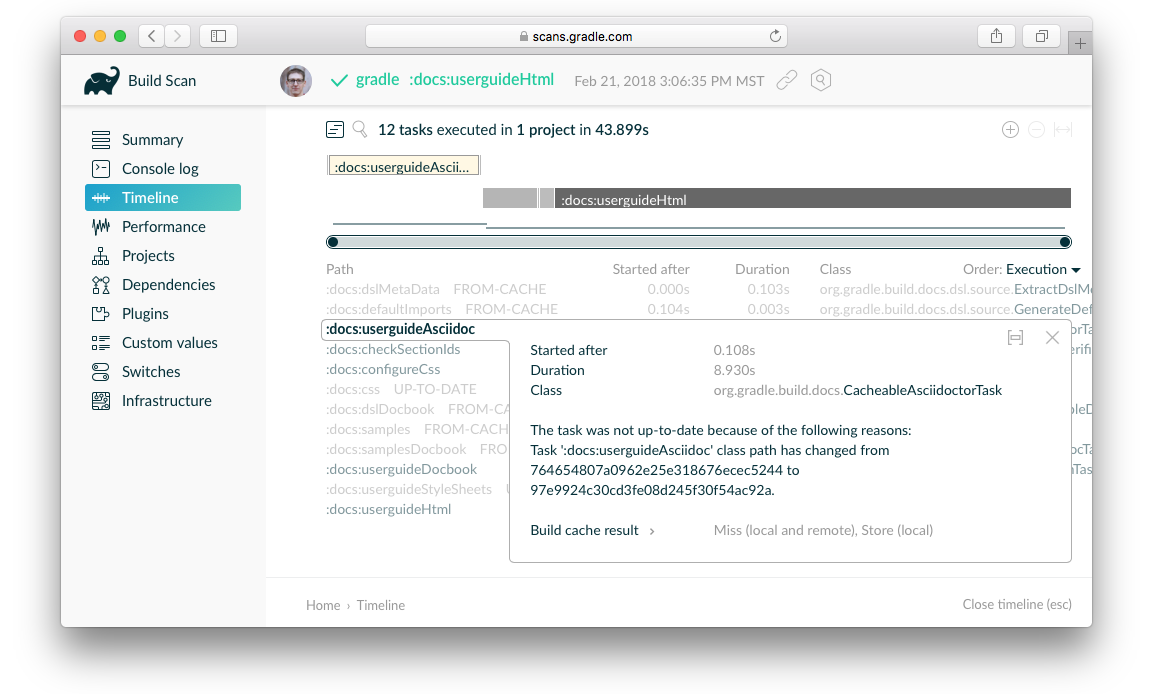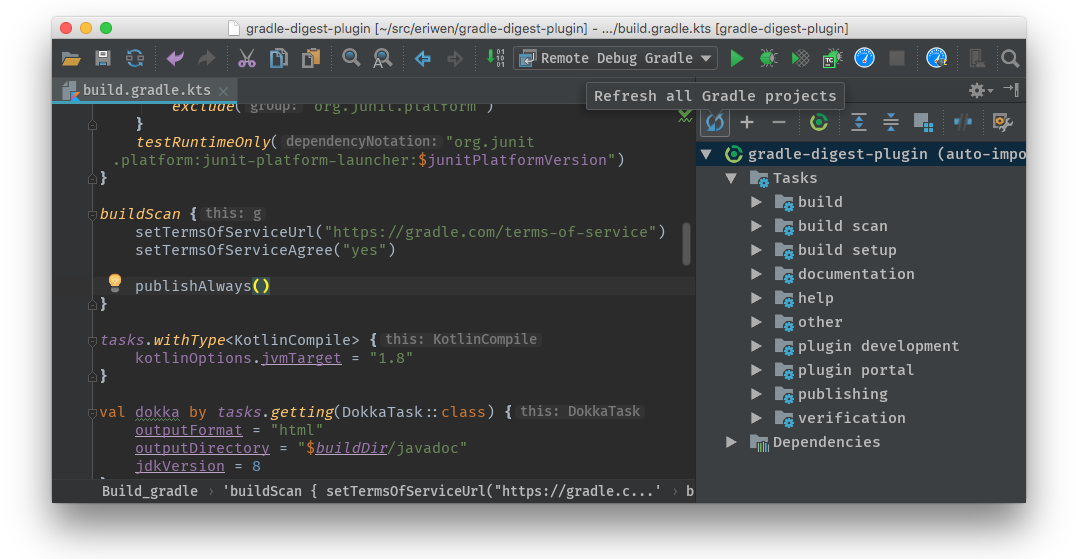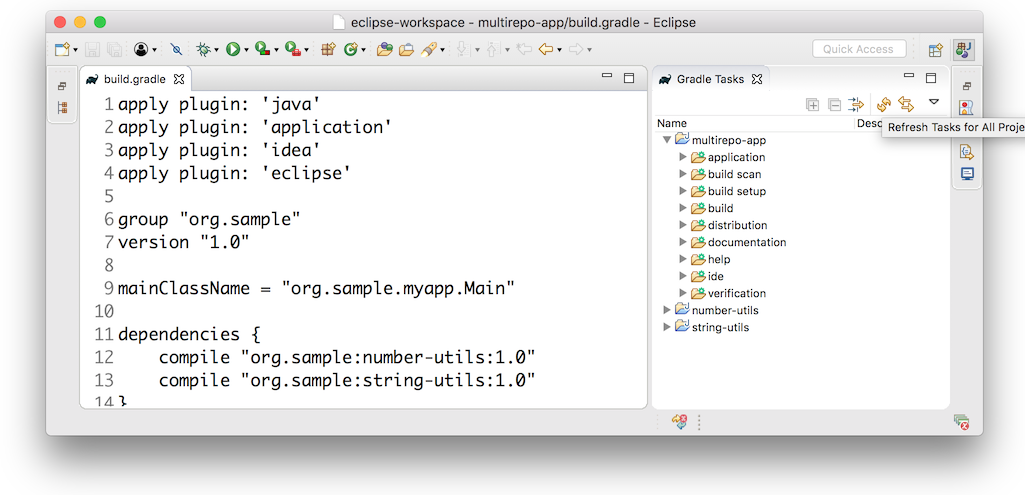Troubleshooting
The following is a collection of common issues and suggestions for addressing them. You can get other tips and search the Gradle forums and StackOverflow #gradle answers, as well as Gradle documentation from help.gradle.org.
Troubleshooting Gradle installation
If you followed the installation instructions, and aren’t able to execute your Gradle build, here are some tips that may help.
If you installed Gradle outside of just invoking the Gradle Wrapper, you can check your Gradle installation by running gradle --version in a terminal.
You should see something like this:
❯ gradle --version ----------------------------------------------------------- Gradle 4.6 ------------------------------------------------------------ Build time: 2018-02-21 15:28:42 UTC Revision: 819e0059da49f469d3e9b2896dc4e72537c4847d Groovy: 2.4.12 Ant: Apache Ant(TM) version 1.9.9 compiled on February 2 2017 JVM: 1.8.0_151 (Oracle Corporation 25.151-b12) OS: Mac OS X 10.13.3 x86_64
If not, here are some things you might see instead.
Command not found: gradle
If you get "command not found: gradle", you need to ensure that Gradle is properly added to your PATH.
JAVA_HOME is set to an invalid directory
If you get something like:
ERROR: JAVA_HOME is set to an invalid directory Please set the JAVA_HOME variable in your environment to match the location of your Java installation.
You’ll need to ensure that a Java Development Kit version 8 or higher is properly installed, the JAVA_HOME environment variable is set, and Java is added to your PATH.
Permission denied
If you get "permission denied", that means that Gradle likely exists in the correct place, but it is not executable.
You can fix this using chmod +x path/to/executable on *nix-based systems.
Other installation failures
If gradle --version works, but all of your builds fail with the same error, it is possible there is a problem with one of your Gradle build configuration scripts.
You can verify the problem is with Gradle scripts by running gradle help which executes configuration scripts, but no Gradle tasks. If the error persists, build configuration is problematic.
If not, then the problem exists within the execution of one or more of the requested tasks (Gradle executes configuration scripts first, and then executes build steps).
Debugging dependency resolution
Common dependency resolution issues such as resolving version conflicts are covered in Troubleshooting Dependency Resolution.
You can see a dependency tree and see which resolved dependency versions differed from what was requested by clicking the Dependencies view and using the search functionality, specifying the resolution reason.

The actual build scan with filtering criteria is available for exploration.
Troubleshooting slow Gradle builds
For build performance issues (including “slow sync time”), see the guide to Improving the Performance of Gradle Builds.
Android developers should watch a presentation by the Android SDK Tools team about Speeding Up Your Android Gradle Builds. Many tips are also covered in the Android Studio user guide on optimizing build speed.
Debugging build logic
Attaching a debugger to your build
You can set breakpoints and debug buildSrc and standalone plugins in your Gradle build itself by setting the org.gradle.debug property to “true” and then attaching a remote debugger to port 5005.
❯ gradle help -Dorg.gradle.debug=true --no-daemon
In addition, if you’ve adopted the Kotlin DSL, you can also debug build scripts themselves.
|
✨
|
You must either stop running Gradle Daemons or run with --no-daemon when using debug mode.
|
Adding and changing logging
In addition to controlling logging verbosity, you can also control display of task outcomes (e.g. “UP-TO-DATE”) in lifecycle logging using the --console=verbose flag.
You can also replace much of Gradle’s logging with your own by registering various event listeners. One example of a custom event logger is explained in the logging documentation. You can also control logging from external tools, making them more verbose in order to debug their execution.
|
✨
|
Additional logs from the Gradle Daemon can be found under GRADLE_USER_HOME/daemon/<gradle-version>/.
|
Task executed when it should have been UP-TO-DATE
--info logs explain why a task was executed, though build scans do this in a searchable, visual way by going to the Timeline view and clicking on the task you want to inspect.

You can learn what the task outcomes mean from this listing.
Debugging IDE integration
Many infrequent errors within IDEs can be solved by "refreshing" Gradle. See also more documentation on working with Gradle in IntelliJ IDEA and in Eclipse.
Refreshing IntelliJ IDEA
NOTE: This only works for Gradle projects linked to IntelliJ.
From the main menu, go to View > Tool Windows > Gradle. Then click on the Refresh icon.

Refreshing Eclipse (using Buildship)
If you’re using Buildship for the Eclipse IDE, you can re-synchronize your Gradle build by opening the "Gradle Tasks" view and clicking the "Refresh" icon, or by executing the Gradle > Refresh Gradle Project command from the context menu while editing a Gradle script.

Getting additional help
If you didn’t find a fix for your issue here, please reach out to the Gradle community on the help forum or search relevant developer resources using help.gradle.org.
If you believe you’ve found a bug in Gradle, please file an issue on GitHub.